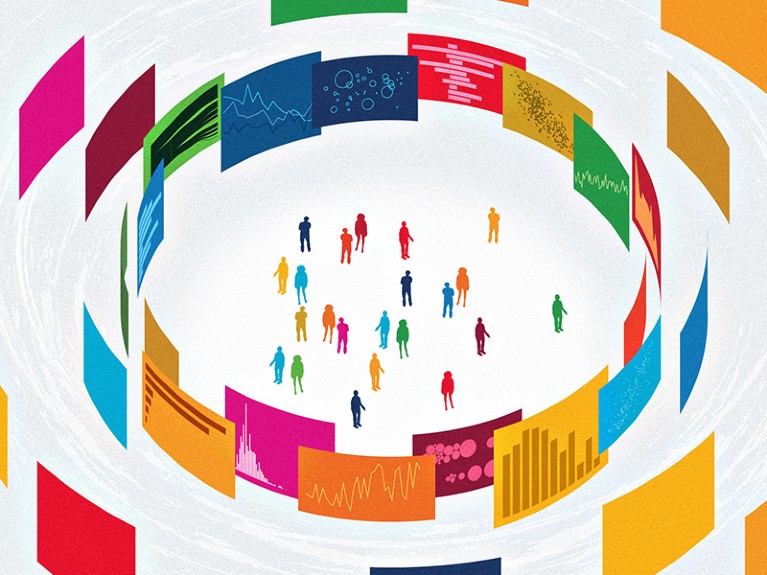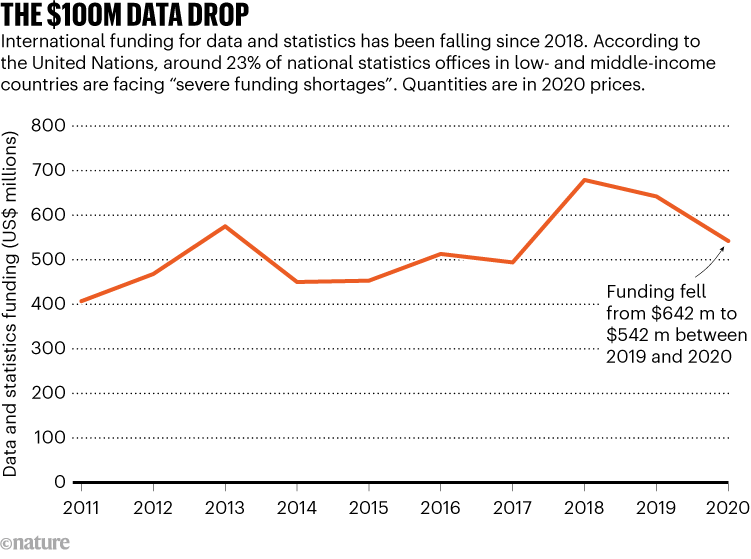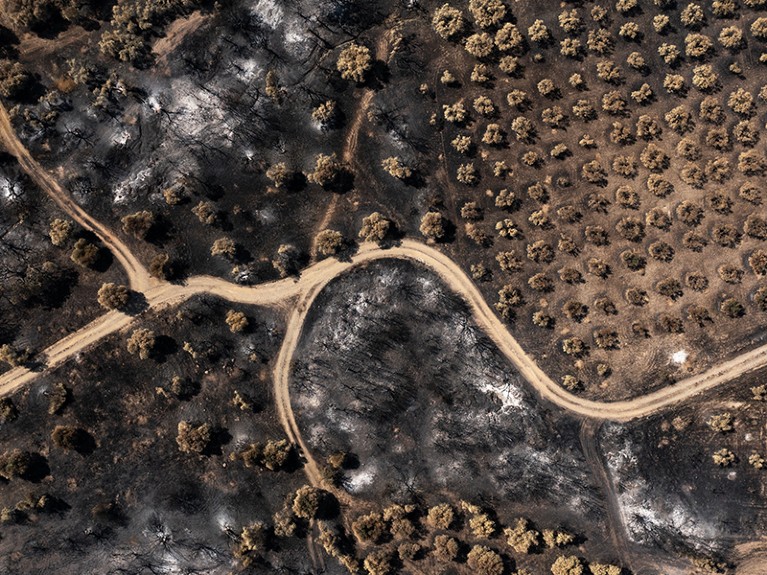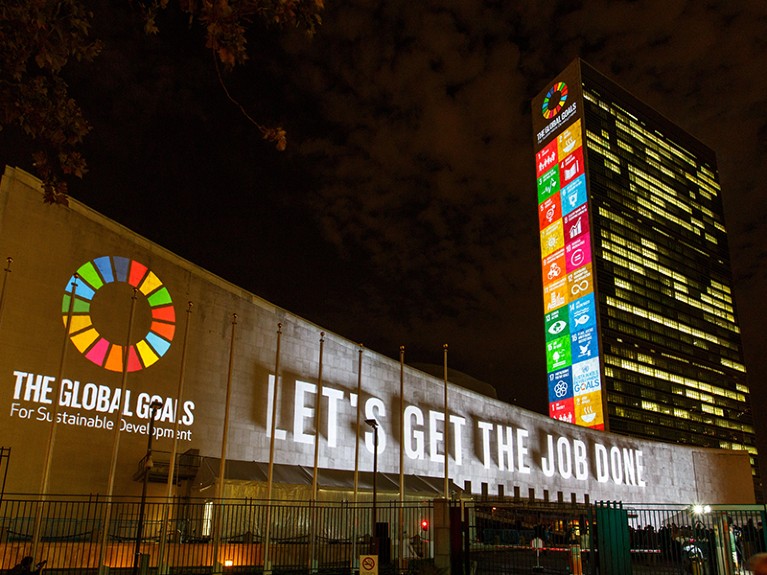
Credit: Jasiek Krzysztofiak/Nature
Eight years ago, the world signed up to an unprecedented project. At a United Nations summit in September 2015, 193 countries agreed to work towards 17 goals with the aim of improving the lives of all people and the planet we inhabit. The Sustainable Development Goals (SDGs) would include efforts to eliminate poverty and hunger, reduce inequalities, rescue the climate and sustain life on Earth — and they would all be achieved by the ambitious deadline of 2030. Never before had nations united on such a bold commitment to improve conditions for humanity and its home.
With the world now halfway to that deadline, the sheer scale of the task is clearer. Over the past three months, Nature has been examining the progress made towards the goals so far, and how researchers are making a difference. Next week, the UN is hosting a summit in New York City to inject new energy and urgency into efforts to meet the goals. So, what needs to be done, and what further part can the global research community play? Our reporters have spoken to around 100 researchers and policy specialists across a range of disciplines to find out.
By some indications, the goals have had an extraordinary impact in a relatively short time. The SDGs have entered the global lexicon: they feature in government and corporate plans, and their multicoloured logos are taped to classroom walls around the world. In 2019, a global survey by the World Economic Forum of almost 20,000 people across 28 countries found that 74% of respondents had heard of the goals.
Progress towards the Sustainable Development Goals
But when it comes to progress towards the goals and their 169 linked targets, the report card is grim. In the first few years after 2015, the world was inching forwards: child mortality and extreme poverty were falling, for instance, and access to electricity was increasing. But shifting geopolitics, the COVID-19 pandemic, the unassailable force of climate change and the war in Ukraine have undermined most of the gains.
Only about 12% of the targets are now likely to be met by the deadline, and on around 30%, progress has stagnated or gone backwards. An estimated 575 million people will still be living in extreme poverty in 2030. By that time, the world is also likely to have broken the goal of limiting global warming to within 1.5 °C of pre-industrial temperatures, which was agreed at the 2015 Paris climate summit. And on the current trajectory, gender gaps and discrimination will not be eliminated for another 286 years.
Although this state of affairs is demoralizing, it would be wrong to give up. Failure to achieve a worthy goal is not a reason to abandon it. It’s a reason to study what went wrong, regroup and adjust course — for 2030 and beyond.
Sounds of the ’60s
The UN has been setting global goals since at least the 1960s as a way to focus attention on the needs of the world’s poorer countries. This idea gained prominence with the Millennium Development Goals, a set of eight international development targets — such as halving extreme poverty and achieving universal primary education by 2015 — that were set in 2000.
Research in the workplace supports the intuitive idea that goal-setting can improve people’s performance — provided that the goals are clear and achievable, and individuals buy into them and receive regular feedback. But it’s not known whether setting global goals is effective at accelerating progress in the same way, or whether it can motivate change on a monumental scale. Although some countries made good progress towards the Millennium Development Goals, it’s hard to say how much of that progress would have occurred anyway.
The principle of the SDGs was established by Paula Caballero and Patti Londoño, two policymakers from Colombia, and is described in vivid detail in their 2022 book Redefining Development. The goals were groundbreaking because they combined nations’ social and economic aspirations with environmental ones to form one set of integrated goals. This encapsulated the idea that progress in living conditions must occur hand in hand with protection of the planet, and that these objectives must apply to all countries, not only the poorest.
But politicians’ response to the SDGs has been lacklustre. Starting in 2020, a team of 61 researchers scoured more than 3,000 academic studies published between 2016 and 2021 for scientific evidence that the SDGs were having an impact on politics1. The meta-analysis, led by Frank Biermann, who studies global sustainability governance at Utrecht University in the Netherlands, showed that although the SDGs were influencing political discussions, there was little evidence they were driving substantive changes in government policies or spending. To correct their course, governments must engage beyond this superficial level.
Measuring up
Nature’s focus has been on how science can help. We are committed to publishing more research that assesses the SDGs’ progress and showcases effective interventions that could help to achieve them. One clear message from our reporting is that measurement of progress towards the SDGs needs to be improved. The UN publishes an agreed set of some 230 indicators — such as the proportion of a country’s population living below the international poverty line and the proportion of land degraded. But although hundreds of individuals at a range of organizations painstakingly collect and check national statistics, there are still vast gaps, particularly for low- and middle-income countries, and in data disaggregated by gender. For several cross-cutting goals, such as climate action, gender equality and peace and justice, fewer than half of countries or areas have internationally comparable data. Moreover, donors cut funding for the collection of data and statistics by US$100 million between 2019 and 2020 (the most recent year for which data are available) — the biggest drop since the SDGs began (see ‘The $100m data drop’).

Source: UN/PARIS21
Researchers also argue that some of the measures agreed by the international community in 2015 are too simplistic and inaccurate, and have devised newer ways of measuring progress towards the SDGs. For example, the projection that around 575 million people will remain in extreme poverty in 2030 is based on the World Bank’s definition, which states that those below the poverty line live on no more than $2.15 per day at 2017 prices. But in many parts of the world, people earning well above this threshold cannot afford basic food or housing (see Nature 618, 886; 2023). An alternative measure is the Multidimensional Poverty Index (MPI), developed by researchers at the University of Oxford, UK, and the UN Development Programme. The MPI captures other indicators of poverty, such as the quality of housing and access to clean water and sanitation, and suggests that there are likely to be around twice as many people living in extreme poverty.
Narrow focus
Another problem is siloed thinking. Although a founding principle of the SDGs was that they were integrated, that aspect has been neglected by most efforts to achieve or measure them. Each target has its own cascade of indicators, and both national and multilateral agencies tend to focus on one area — the environment, health, development and so forth. This means that even when policymakers take action to support one goal, they typically don’t consider how it might push others forwards or backwards — progress to reduce hunger and promote sustainable agriculture (SDG 2), for example, can conflict with efforts to protect biodiversity on land (SDG 15).
The study and measurement of these SDG interlinkages has become a research field in its own right2 and has helped to show that progress on a subset of SDGs — including poverty, good health, education, gender equality, clean water and clean energy — offer particularly big wins by producing synergistic benefits across many others.

Last month’s forest fire in Greece was the largest ever recorded in the European Union.Credit: Konstantinos Tsakalidis/Bloomberg/Getty
Such interactions are complex, and researchers need to further develop and test straightforward tools that allow policymakers to assess them. A team at the Stockholm Environment Institute (SEI), for example, has developed an approach to assess interactions between targets called SDG Synergies. This was piloted in workshops with the Mongolian government in 2017. Participants used a matrix to score the degree to which a range of possible development actions (such as protecting water) could boost or curtail other goals (such as biodiversity or health), and so worked out which to prioritize. This type of analysis is now required in Mongolia when new development policy proposals are considered, and the tool has since been used to analyse SDG links in countries from Mexico to Sri Lanka. Ahead of next week’s summit, researchers at the SEI are pushing for a wider adoption of such tools, among other things3.
Evidence ignored
Another message many of our reporters heard is about the difficulty in getting practitioners or policymakers to use research. Reams of evidence on effective ways to help children learn, for example, are rarely used in classrooms or by education ministries. And research showing that clean energy can drive progress towards many SDGs without hindering economic development is consistently ignored.
Widespread frustration at this chasm between research and policy is fuelling interest in studying the problem in its own right. There are plenty of anecdotes and theories about what does or doesn’t work to get science and evidence used — building trust and relationships between researchers and policymakers, for example — but most people trying to get evidence used are not going about it in a systematic way.
One of the most coordinated efforts to address this is the Transforming Evidence Network, a group started in 2020 that now includes several hundred funding organizations, researchers, community leaders and government representatives. Its aim is to build up a body of evidence about effective methods for getting research used.
Policymakers and the UN are already discussing what should come after 2030. One idea, which draws on studies of SDG interactions, is to focus on a smaller number of cross-cutting goals — including human well-being, energy decarbonization and sustainable and just economies (see Nature 618, 647; 2023).

It’s time to focus minds and double down on efforts to meet the Sustainable Development Goals, not give up and risk eroding fragile gains.Credit: Xinhua/Alamy Live News
Getting the job done
We strongly support efforts to learn from the past and to take heed of evidence. But completely replacing the goals after 2030 would be wrong-headed, given how widely recognized they have become, and that they all remain essential to sustainable development. Any effort to replace them would detract from the spirit of inclusion that distinguished the SDGs project from previous goals.
But making no adjustments would also be foolhardy, given all that’s been learnt over the past eight years. This month’s summit is focused on re-energizing nations to push for the goals in the run-up to 2030. In the near term, that’s the right approach: even if most targets will be missed, it’s better to double down on efforts and use the deadline to focus minds than to give up and risk eroding fragile gains. This unprecedented project was always going to involve tremendous hard work, and a lot can be done in seven years. The world’s priority must be to make the greatest possible gains against the current goals — while using science to intelligently evolve them.


 Progress towards the Sustainable Development Goals
Progress towards the Sustainable Development Goals
 How much progress are we making on the world’s biggest problems? Take this quiz on plans to save humanity
How much progress are we making on the world’s biggest problems? Take this quiz on plans to save humanity
 Bucking the system: the extraordinary story of how the SDGs came to be
Bucking the system: the extraordinary story of how the SDGs came to be
 Gender equality: the route to a better world
Gender equality: the route to a better world
 Hypocrisy is threatening the future of the world’s oceans
Hypocrisy is threatening the future of the world’s oceans
 Beyond greenwashing: how to make business and finance genuinely sustainable
Beyond greenwashing: how to make business and finance genuinely sustainable
 The science is clear: sustainable development and climate action are inseparable
The science is clear: sustainable development and climate action are inseparable
 Tackle ever-growing consumption to safeguard sustainability gains
Tackle ever-growing consumption to safeguard sustainability gains
 GDP at 70: why genuinely sustainable development means settling a debate at the heart of economics
GDP at 70: why genuinely sustainable development means settling a debate at the heart of economics
 Reducing inequality benefits everyone — so why isn’t it happening?
Reducing inequality benefits everyone — so why isn’t it happening?
 A decades-long decline in extreme poverty has gone into reverse — here’s how to fix things
A decades-long decline in extreme poverty has gone into reverse — here’s how to fix things
 How to educate the world: prioritize funding and data
How to educate the world: prioritize funding and data
 Water crisis: how local technologies can help solve a global problem
Water crisis: how local technologies can help solve a global problem
 Hunger and famine are not accidents — they are created by the actions of people
Hunger and famine are not accidents — they are created by the actions of people
 Want a sustainable future? Then look to the world’s cities
Want a sustainable future? Then look to the world’s cities
 Clean energy can fuel the future — and make the world healthier
Clean energy can fuel the future — and make the world healthier
 The best medicine for improving global health? Reduce inequality
The best medicine for improving global health? Reduce inequality




